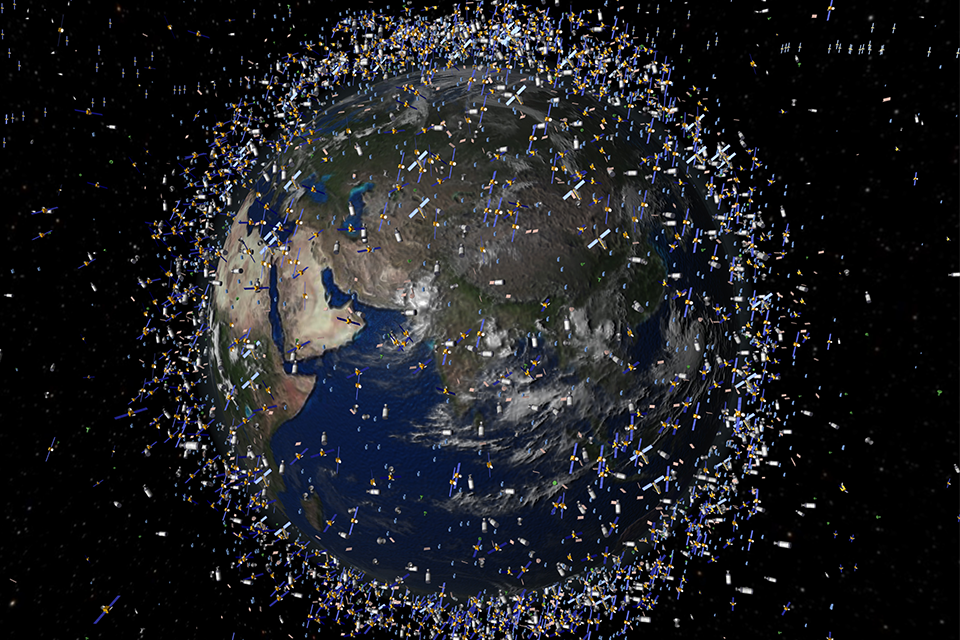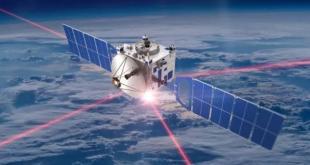By Dr. Sara Langston and Kayla Taylor

Outer space presents myriad concepts for creating inspiration and opportunity as well as challenges. With over 8,000 satellites currently in Earth orbit, reliance on satellite services for communications, imaging, and navigation has become ubiquitous to enhancing the quality of life on Earth. In fact, satellite communication has been deemed a public good since the early 1960s, which has enabled public reliance on space-based telecommunications. Other key satellite applications include weather forecasting, climate monitoring, and navigation support for global transportation. The United Nations Office for Outer Space Affairs fully acknowledges the benefits that space-based assets provide in supporting the UN Sustainability Goals of 2030 across all 17 sectors of society and activity, including education, environment, and infrastructure. The use of satellites has also transformed the way that scientists can conduct experiments and observe the universe. However, the growing number of satellites in orbit is creating a negative impact and changing the accessibility of dark and quiet skies for conducting ground-based Astronomy.
Astronomy maintains an ancient heritage as one of the oldest sciences in the history of humanity. Observations of the solar system and even the galaxy led to revolutions in scientific, societal, and even religious thinking over the past millennia. Space technologies further enable the quest of scientists, philosophers, and amateur astronomers to learn about the cosmos and rationally contemplate our place and significance in it. However, in recent years, recreational and professional stargazing has been negatively affected by the booming satellite industry, particularly with regard to the proliferation of small satellites. Swarms of satellites, often referred to as satellite “constellations,” are regularly and routinely launched in support of satellite systems for providing commercial communication and earth observation services and products. These satellite constellations are growing rapidly, with some constellations already boasting nearly 5,000 individual satellites. The rise of “mega-constellations” is particularly concerning to astronomers because satellites add light pollution and technological noise to the night sky and impede sensitive astronomical measurements, making observations progressively more difficult.
The present quandary centers on how to optimize the use and benefits of satellites without obstructing important scientific observations of the night sky. Balancing the interests of astronomers and satellite operators is an increasingly pertinent issue, with international and scientific dialogues converging on the future of dark and quiet skies in recent years. In fact, the United Nations Committee on the Peaceful Uses of Outer Space Scientific and Technical Subcommittee met at the beginning of February and discussed the urgency of preserving a dark and quiet night sky from satellite interference. Despite the timeliness of the topic, public dialogues on satellite pollution often focus on the potential negative effects of light pollution without also identifying and promoting the benefits of dark and quiet skies. The value of dark skies to life on Earth is often missing in the policy and industry discourse, yet it is a necessary and persuasive aspect for considering the implications if we cannot resolve the conflicting interests of astronomers and satellite operators.
Dwindling Skies
Humans have a deep-rooted historical connection with the night sky. Astronomy developed very early on during human existence and relatively simply: it only required that humans look up at the night sky and wonder what was “out there.” Ancient beliefs from a variety of diverse cultures and civilizations have taught us how astronomy has been culturally significant and regarded as sacred for thousands of years. Astronomy also formed the necessary basis for a variety of societal functions that were critical to human evolution, including calendars, agriculture, navigation, and weather forecasting.
The earliest astronomical measurements suggest that humans have been recording what they saw in the sky for thousands of years, but it was not until the early 17th century that scientists began using spyglasses as a type of rudimentary telescope to look at the stars. Telescopes grew larger and more powerful until, at last, humans were able to launch telescopes into space in the late 1960s to view the stars and planets without the impediments of Earth’s thick atmosphere. These technological feats alone, although remarkable, show how astronomers have only briefly begun to observe the cosmos directly from space.
The coexistence of humans and the natural environment requires that we compromise for the betterment of both.
Despite the wealth of knowledge that space-based telescopes have given scientists, ground-based observing remains the primary way that astronomers examine the night sky. The economic hurdles associated with sending a telescope into space far exceed the resources of an average astronomer, so dark skies must be maintained to meet the needs of astronomy research. Finding a balance between preserving dark skies for astronomy and utilizing the essential services of satellites poses a complex challenge that becomes even more complicated when considering the legal frameworks that govern outer space activities.
Space Law: A Regulatory Constellation Itself
Another challenge lies in identifying the law and policy landscape applicable to addressing these issues. First, whether the current space law framework, designed to govern actors and activities engaging in space activities, is applicable and/or adequate to address dark skies issues? Ground-based astronomy is a lawful and valuable science-based activity, as is placing satellites in orbit for commercial and scientific purposes—but what happens when astronomers and satellite operators want to do something at the same time and utilize the same section of outer space?
Under international law, the use of space is governed by a treaty framework. The 1967 Outer Space Treaty (OST) provides foundational principles for the use of space and has garnered widespread acceptance since its adoption. The OST also established the principle that outer space should be used for the benefit of all humankind. Although the OST provides foundational “rules of the road” for space-based activities, it doesn’t provide specific or clear resolutions for emerging challenges such as growing orbital space debris, or in this case, the conflict of interests between the use of Earth orbit and space access for astronomy versus satellite operations.
The subsequent treaties to the OST, including the Liability Convention and Registration Convention, are relevant to space actors‘ responsibility, liability, and the sustainable operation of satellites and mega-constellations. However, the Liability Convention pertains to direct harm caused by space objects; consequently, light pollution and satellite interference are not applicable here. Even particle emissions from launch/re-entry vehicles and satellites, which can interfere with astronomy, are not covered under these treaties. As new and emerging environmental issues, the treaties cannot appropriately address the technological challenges posed by an era of proliferating satellite mega-constellations. This highlights a challenging yet urgent need for international policymakers and the scientific community to cooperate, harmonize, and act on the future of dwindling dark and quiet skies.
Moving Down the Legal Pipeline: Other Pertinent Governing Frameworks
The astronomy community has voiced concerns regarding a lack of enforceable international law on the mitigation of light pollution from satellites. While the concerns for the future of astronomy are scientifically justifiable, it is likewise challenging for any international forum to agree on a legal framework that would establish specific rules for astronomers and space observations. These challenges are present due to complexities of law, national jurisdictional issues, and concurrent lawful uses of space by astronomers and satellite operators. As a result, international law does not currently provide a sufficient means for balancing the conflicting interests present.
Looking to national laws and policies can help inform our legal discussion of dark skies, and the United States is a crucial case study in this situation. With numerous commercial satellite companies headquartered in the United States, including SpaceX’s Starlink and Amazon’s Project Kuiper, the United States has significantly shaped the landscape of satellite operations and regulation. National laws in the United States have promoted and regulated the conservation of natural resources for more than 100 years, but U.S. laws do not directly address the natural resource of “dark skies” in the realm of space. Instead, many U.S. laws address artificial light at night (ALAN), with many states establishing standards regarding the installation of shielded light fixtures, the use of low-wattage lighting, and the formation of state dark sky sites.
Dark Sky laws and policies in the United States are indicative of successful lobbying efforts by concerned individuals. The International Dark Sky Association (IDA) is one prominent organization that conducts grassroots-level initiatives to promote dark sky outreach and education both for the general public and various law-making/public policy entities. Community and stakeholder efforts, like the IDA, serve as a consistent voice for legitimate scientific concerns, interests, as well as social and environmental values that provide information for policymakers. The overarching dark sky ideals exhibited by U.S. law and policy can benefit future decision-making by informing policymakers of the light pollution principles that have guided previous legislation.
Ethical Skies
Ethics provides principled reasoning that can guide policymaking to balance the conflicting interests of astronomers and satellite operators. Understanding the ethical values at stake, should dark skies remain unprotected, empowers policymakers to implement informed legislation. Three core ethical values worthy of consideration for dark skies discussions include beneficence, respect for persons, and respect for nature.
Beneficence refers to the moral obligation to “do good.” Dark skies promote beneficence such that the natural conditions of the sky benefit life on Earth. The global issue of satellite light pollution reveals the significant scope of potential health consequences that life will face as satellites’ albedo illuminate the night sky. Natural levels of daylight and darkness are essential to the function and evolution of vegetation, animals, and their habitats. Moreover, studies suggest that the disruption of human circadian rhythms as a result of light pollution and ALAN can increase obesity, insomnia, and certain types of cancer. Dark skies are fundamental to fostering beneficial living conditions for plants, animals, and humans alike.
The value of dark skies to life on Earth is often missing in the policy and industry discourse.
Respect for persons acknowledges the value that pertains to how humans are free to think, make choices, and behave independently. Satellite constellations that alter or block the view of the stars disconnect humans from the pristine dark skies that civilizations and cultures have viewed and revered for millennia. The natural night sky has long inspired peoples and cultures, including the Aboriginal and Torres Strait Islander people, to recognize the shared heritage of the sky, fostering valued cultural traditions, legacies, and education. Respect for persons also encompasses future generations so that future individuals can experience cultural and educational opportunities resulting from dark skies. Increasing satellite light pollution inextricably impacts existing philosophical, cultural, and educational values of dark skies, which undermines an ethical approach to respect for persons.
Respect for nature extends respect to other nonhuman living beings. Significant scientific evidence suggests that ALAN can have considerable adverse effects on the activity patterns, growth rates, and reproductive abilities of various wild animals. Likewise, biologists have observed troubling reductions in height and seed yield for plants that were exposed to ALAN. The coexistence of humans and the natural environment requires that we compromise for the betterment of both. Although changes in our relationship with the environment, such as operating satellites in Earth’s orbit, are not unethical per se, change while an inevitable part of life should not create more negative effects on the environment.
The ethical values of beneficence and respect show the weight that an ethical understanding can contribute to informing decision-makers. Hence, legal knowledge and science education alone cannot sufficiently promote efforts to protect astronomy while simultaneously meeting the interests of satellite operators. The diverse approaches presented by law, policy, and ethics provide a sensible basis for informing prudent policy and decision-making.
Balancing the Cosmic Scales: Finding Compromise
While space law inevitably needs to adapt to the fast-paced reality of a growing space industry, international cooperation is setting the stage for balancing the conflicting interests of astronomers and satellite operators. Astronomers, satellite manufacturers, and lawmakers inevitably must find mutually beneficial solutions together. Collaborative efforts are already leading to innovative technologies that are gaining traction to preserve both the benefits of satellite connectivity and the scientific knowledge that we gain from astronomers and stargazers alike. However, these collective efforts must make timely progress if this issue is to be efficiently addressed. Ultimately, stakeholders in this conflict must prioritize solutions to preserve the night sky for ongoing human benefit while simultaneously using space for commercial purposes.
For additional discussion on the topic see “Evaluating the benefits of dark and quiet skies in an age of satellite mega-constellations.”

Dr. Sara Langston is an Assistant Professor of Spaceflight Operations at Embry-Riddle Aeronautical University. She is an international aerospace lawyer, practical ethicist, and U.S. Army veteran with a technical aviation background. As a consultant, Dr Langston provides strategic advice to government agencies and private industry on developing national space law and policy, space applications, and commercial human spaceflight. Dr. Langston holds a Ph.D. in the History and Philosophy of Science; a J.D. with specialization in Public International Law; an LL.M. in Air and Space Law; and a Space Studies Certificate in Physical Sciences from the International Space University. In addition, Dr. Langston served as an UNOOSA Space4Women Mentor and is a member of the International Institute of Space Law, the Royal Aeronautical Society, and the New York and District of Columbia Bars.

Kayla Taylor is an aspiring doctoral candidate with a background in the space sciences. Her academic interests focus on balancing the opportunity and impact of human innovation, scientific inquiry, and space exploration. She has researched and published on a variety of STEM-related issues, from gender discrimination in the physical sciences to evaluating the effect of various forms of light pollution on ground-based astronomy. Applying her technical background to integrate the broader scientific landscape and address multidisciplinary questions, her work serves to reimagine and support the exploration of the cosmos. Kayla holds a BS in Astronomy and Astrophysics and an MS in Aviation with a specialization in Space Studies from Embry-Riddle Aeronautical University.
 SpaceWatch.Global An independent perspective on space
SpaceWatch.Global An independent perspective on space




